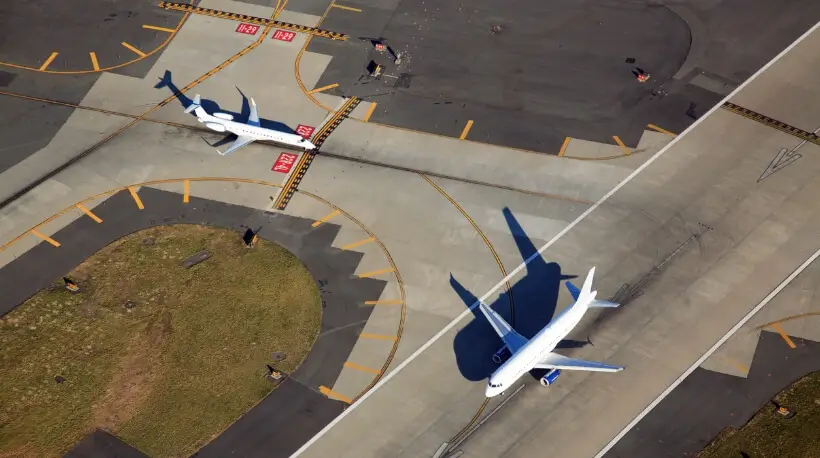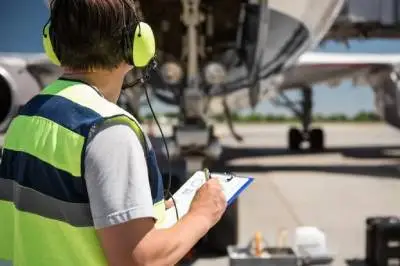This article explains the importance of airport runway markings and signs to ensure the safety and efficiency of aviation operations, detailing how these visual cues guide pilots through takeoff, landing and taxiing.

Being an aviator is no small feat – your work begins long before takeoff, right on the ground with the lines, numbers and letters that dot our runways and taxiways. Yes, we're talking about airport runway markings and signs, the critical information that ensures the operational safety and efficiency of every flight. Have you ever wondered how runway markings can guide pilots through the most critical phases of pre and post-flight operations? Well, you're in the right place.
This article breaks down essential airport runway markings and signs that every new and experienced pilot should know. From deciphering color-coded signs to recognizing the patterns that dictate movement and positioning on the ground, we're here to shed light on the visual cues that keep operations running smoothly at airports worldwide.
A Closer Look at Airport Runway Markings
Airport runway markings are the symbols, numbers and patterns found on airport runways, which communicate crucial information to pilots during takeoff, landing and taxiing operations. Airport runway markings are wholly dedicated to safety operations and orientation, ensuring pilots use the runway correctly, maintain the correct path and speed and serve as visual cues for ground crews and Air Traffic Control. Understanding runway markings is like learning a new language (much like avionics systems) – one that guides pilots as they navigate aircraft through takeoffs and landings.
The Color Code
All taxiway and runway markings will follow a simple FAA-compliant color scheme of white and yellow to prevent confusion and misidentification. Airport runway markings are predominantly white, chosen for their stark contrast against dark runway pavement for visibility at all times, even in adverse weather conditions.
Taxiway markings, on the other hand, are yellow, providing a clear visual distinction between areas intended for landing and those for maneuvering around the airport. Holding positions will also have yellow markings, even on the runway itself.
Runway Designation Markings
One of the first things that catches the eye when looking at a runway is the designation markings. These consist of numbers (and sometimes a letter) painted on each end of the runway. But what do these numbers mean, and how are they determined?
The runway designation marking plays a role in aviation navigation, denoting the runway's orientation relative to magnetic north. This number is derived by taking the runway's compass heading and rounding it to the nearest tenth. For instance, a runway aligned with a compass heading of 90 degrees toward the east is designated as runway 09. Similarly, the opposite end of the same runway, which would point towards 270 degrees (west), is marked as runway 27.
In cases where parallel runways exist, an additional letter (L, R or C) is appended to distinguish between them – standing for Left, Right or Center, respectively.
Runway Threshold Markings
Runway threshold markings demarcate the beginning of a runway available for landing. These consist of parallel lines stretching across the runway, signifying to pilots that they are crossing into a zone designated for landing or takeoff.
There are two different runway threshold marking types:
- Eight identical lines on either side of the centerline (four on either side).
- Identical lines, the number of which is determined by the width of the runway.
When the second marking configuration is used, the following numbers help denote the width of the runway:
- 4 stripes: 60 ft. Wide
- 6 stripes: 75 ft. Wide
- 8 stripes: 100 ft. Wide
- 12 stripes: 150 ft. Wide
- 16 stripes: 200 ft. Wide
Runway Centerline Markings
Centerline markings run down the middle of the runway and provide a critical alignment guide for aircraft during takeoff and landing. These long, continuous stripes ensure that pilots maintain the aircraft's position at the runway's center, optimizing safety margins by maximizing distance from the runway edges.
Touchdown Zone Markings
Located just beyond the runway threshold, touchdown zone runway markings identify the area intended for the initial contact of landing aircraft. These markings consist of pairs of rectangles arranged in groups, indicating the safest and most efficient area to land.
The touchdown zone is critical for managing landing distances, allowing pilots to make precise landings that contribute to the aircraft's braking efficiency and overall safety on the runway.
Aiming Point Markings
Within the touchdown zone, you'll find the aiming point markings, consisting of two broad stripes on either side of the centerline. These serve as visual targets for pilots to aim at during the landing approach, ensuring the aircraft descends at the optimal angle and position for a smooth touchdown.
Aiming point markings are essential for precision in landing, especially in larger aircraft that require careful management of descent and landing speeds.

Deciphering Airport Runway Signs
While airport runway markings lay the groundwork for visual navigation on the pavement, airport runway signs serve as critical markers that guide pilots along taxiways and runways. Let's unravel the language of these signs to understand how they contribute to the smooth and safe movement of aircraft on the ground.
Location Signs
Location signs are crucial for situational awareness, providing pilots with immediate confirmation of their location on the airport surface. Location signs are typically square or rectangular with a yellow background and black lettering, indicating the taxiway or runway on which the aircraft is currently located. Recognizing these signs is fundamental for pilots to prevent inadvertent runway incursions or taxiway confusion.
Direction Signs
As the name suggests, direction airport runway signs offer guidance on the direction to take to reach specific points of interest, such as runways, taxiways, terminals or services.
These signs have a black background with white lettering and arrows pointing toward the direction the pilot should take. They are often found at intersections, helping pilots make informed decisions about turns and ensuring they follow the correct path to their intended destination.
Destination Signs
Destination signs provide information about destinations accessible from a particular point, similar to direction signs but more specific in their intent. These signs help pilots navigate to key areas such as runways, aprons and important airport facilities.
With a yellow background and black inscription, destination signs often include symbols or abbreviations for various airport locations (e.g., "R" for runway, "TWY" for taxiway), along with arrows indicating the direction.
Information Signs
Information signs convey essential operational information that pilots need to know. This category includes a wide range of signs, from general airport information to specific instructions like "NO ENTRY" or operational details about the airport layout. The background and text color can vary depending on the type of information provided.
Together, airport runway signs and markings create a comprehensive system of ground-based navigation aids that ensure aircraft's orderly and safe movement. By understanding and accurately interpreting markings and signs, pilots can confidently maneuver their aircraft, ensuring compliance with air traffic control instructions and minimizing the risk of on-ground incidents.
Special and Supplementary Runway Markings
Beyond the standard runway markings and signs, many airports incorporate a variety of special and supplementary markings designed to address unique situations or enhance safety under certain conditions. Let's explore these additional markings and understand their roles in the intricate ballet of airport operations.
Displaced Thresholds
A displaced threshold is a section of the runway at the beginning that is not available for landing but can be used for takeoff and taxiing. This is indicated by arrowhead lines pointing towards the direction of the landing threshold.
The purpose of a displaced threshold can vary, including obstruction clearance, noise abatement or runway wear reduction. Pilots must adjust their landing to start at the displaced threshold, not before, ensuring that the available landing distance meets the aircraft's requirements.
Stop Bars (Lights)
Stop bars are a series of illuminated red lights embedded in the pavement, serving as a do-not-cross signal for aircraft and ground vehicles. They are primarily used at runway-taxiway intersections or critical points where it's essential to control movement for safety reasons. When lit, the stop bar indicates that the aircraft or vehicle must stop and remain stationary until the lights are switched off, signifying clearance from air traffic control to proceed.
Holding Position Markings for Taxiways and Runways
Holding position markings are thick, double solid lines accompanied by double dashed lines, indicating where aircraft should stop when they do not have clearance to enter a runway or critical area. These markings are found at taxiway intersections with runways and at points where it's necessary to hold aircraft for operational reasons.
The solid lines are always on the side where the aircraft must stop, providing a clear visual cue to pilots about holding positions. These markings are crucial for maintaining a safe distance between aircraft and active runways, minimizing the risk of collisions.
Airport Runway Markings Visualized
If you're more of a visual learner, check out this short video explaining the functions of airport runway markings with some visual guides.
Frequently Asked Questions: Airport Runway Markings & Signs
If you have any questions or would like to learn more about airport runway markings and signs, check out the answers to our most frequently asked questions below.
What Measures Are Taken to Ensure Runway Markings Are Visible in Snow?
Airports in regions prone to snow use several strategies to maintain visibility of runway markings, including using reflective and high-contrast paint, employing snow removal equipment to clear markings quickly and sometimes even heating elements embedded in the pavement. Additionally, pilots rely more on instrument approaches and air traffic control guidance when visual cues on the runway are compromised by snow coverage.
What Do the Arrows on Runway Markings Indicate?
Arrows on runway markings, particularly in a displaced threshold or a blast pad/stopway area, indicate the direction the aircraft should move. In the case of a displaced threshold, the arrows point towards the start of the landing portion of the runway.
How Can Pilots Differentiate Between Runway and Taxiway Signs?
Airport runway signs typically have a white background with black letters (indicating the runway number), while taxiway signs have a yellow background with black letters (indicating the taxiway designation). Directional and informational signs have varied backgrounds and colors to convey different types of information.
Master the Runway, Command the Skies: Shop Air Power Inc. Today
It's clear that understanding airport runways and signs is fundamental to the safety and efficiency of every flight. But, as you continue to expand your understanding of airport runway markings and signs, remember that the journey is supported by the strength of your aircraft's components. That's where we come in – providing the best aircraft parts and components for general aviation aircraft of all makes and models.
As the largest distributor of Lycoming Engines and the preferred provider of Continental® Engines, Air Power Inc. ensures that your flights are powered by nothing less than excellence.
Browse All Aircraft Parts
Related Articles: Pre-Flight Checks



